- News
- Reviews
- Bikes
- Accessories
- Accessories - misc
- Computer mounts
- Bags
- Bar ends
- Bike bags & cases
- Bottle cages
- Bottles
- Cameras
- Car racks
- Child seats
- Computers
- Glasses
- GPS units
- Helmets
- Lights - front
- Lights - rear
- Lights - sets
- Locks
- Mirrors
- Mudguards
- Racks
- Pumps & CO2 inflators
- Puncture kits
- Reflectives
- Smart watches
- Stands and racks
- Trailers
- Clothing
- Components
- Bar tape & grips
- Bottom brackets
- Brake & gear cables
- Brake & STI levers
- Brake pads & spares
- Brakes
- Cassettes & freewheels
- Chains
- Chainsets & chainrings
- Derailleurs - front
- Derailleurs - rear
- Forks
- Gear levers & shifters
- Groupsets
- Handlebars & extensions
- Headsets
- Hubs
- Inner tubes
- Pedals
- Quick releases & skewers
- Saddles
- Seatposts
- Stems
- Wheels
- Tyres
- Health, fitness and nutrition
- Tools and workshop
- Miscellaneous
- Tubeless valves
- Buyers Guides
- Features
- Forum
- Recommends
- Podcast
review
£169.00
VERDICT:
Effective at keeping out the rain, but not warm enough
Weight:
960g
Contact:
At road.cc every product is thoroughly tested for as long as it takes to get a proper insight into how well it works. Our reviewers are experienced cyclists that we trust to be objective. While we strive to ensure that opinions expressed are backed up by facts, reviews are by their nature an informed opinion, not a definitive verdict. We don't intentionally try to break anything (except locks) but we do try to look for weak points in any design. The overall score is not just an average of the other scores: it reflects both a product's function and value – with value determined by how a product compares with items of similar spec, quality, and price.
What the road.cc scores meanGood scores are more common than bad, because fortunately good products are more common than bad.
- Exceptional
- Excellent
- Very Good
- Good
- Quite good
- Average
- Not so good
- Poor
- Bad
- Appalling
Lakes CX 145 shoes do a good job of keeping out the water, but could use more insulation so they keep your toes warm too.
I hate getting cold feet. Almost nothing makes me want to turn round and head home more than that feeling of painful, chilled tingling, progressing to icy agony.
Wet feet are almost automatically cold feet, so Lake's CX 145 shoes look like a good first line of defence against frozen toes. They're made from waxed canvas and leather, with a waterproof membrane to keep out the wet.

They're closed by a pair of BOA dials, which nicely spread the pressure across the top of your foot, and can still be used with thick gloves.
The stiff plastic sole is threaded for a three-bolt, Look-pattern cleat and has a couple of lumps of rubber on the heel and toes that help a bit with walking grip. As with any cleated shoe, though, you don't really want to walk further than the distance from bike rack to cafe table in them.
There are slots for two-bolt, SPD-style cleats too, but you can't use them because there's no threaded insert and to fit one would involve cutting open the inner lining of the shoe, making it rather less than waterproof.

I find Lake's sizing generally on the small side and the CX145s are no exception. I can use a 43 in some manufacturer's shoes, but needed a 44 here, especially with the thicker socks I always reach for in winter.
The good news about the CX145s is that, yes, they do keep out the water. As long as you don't immerse them past the Plimsoll Line, and you're careful to arrange tights and socks so they don't conduct rain down into the shoes, they do a good job of excluding the wet stuff.
Problem is, what they don't do very well is keep your feet warm. I found my toes getting chilly after an hour or two, depending just how cold and wet it was.
I think there are two reasons for this. Firstly, there appears to be no insulation between the outer shell of the CX145s and your socks, so your socks are doing most of the work of keeping your feet warm. Problem is, socks can only do so much, and in cold, wet weather, it's not enough.
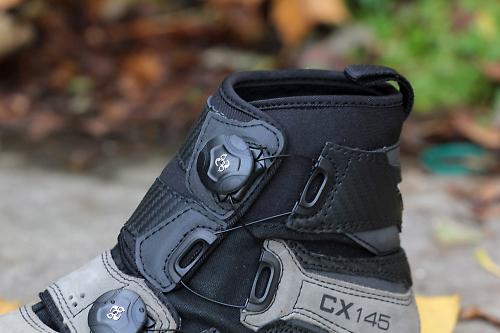
The waxed canvas outer shell appears to be the other half of the problem. The first line of defence of synthetic waterproof fabrics is a durable water repellant coating that makes water bead up and flow off. But that doesn't happen with waxed canvas. Instead, the water wets the outer surface of the fabric. It can't get through, but it sits there.
As the air flows over the shoes, that water evaporates, magnifying the effect of the wind chill that's the reason your feet need more protection from winter. Result: cold toes.

The practical upshot here is that the CX145s will keep your feet dry, but work best when it's not too cold. But when it's cold as well as wet is exactly the time you want your feet to be kept dry AND warm.
Several shoe makers have insulated, waterproof shoes in their ranges, including Lake, though the thinsulate-lined MXZ303s are only available with a mountain bike sole. For horrid British cold and wet winters, Lake could do a lot worse than adapt that shoe for the road, or at the very least add some insulation and a DWR-coated synthetic shell to the next version of the CX145s.
Verdict
Effective at keeping out the rain, but not warm enough.
road.cc test report
Make and model: Lake CX145 Road Water Proof Boot
Size tested: 44, Black
Tell us what the product is for, and who it's aimed at. What do the manufacturers say about it? How does that compare to your own feelings about it?
Lake's blurb is pretty sparse, but it's rather obvious these shoes are for people who don't want to get wet feet while riding in the rain.
My experience indicates they better not mind getting cold feet.
Tell us some more about the technical aspects of the product?
Upper: Waxed Canvas, Leather and a Waterproof membrane for a highly water resistant upper
OutSole: Road Competition fiberglass-injected nylon outsole (3 hole compatible)
Closure: Dual Side mounted BOA Push/Pull lacing system with releasable guides
Colour: Black/Grey
Sizes: Men's, Men's Wide, Woman's specific (M 39-48:50, 39.5-46.5 ; W 36-43, 37.5-42.5)
Rate the product for quality of construction:
8/10
Rate the product for performance:
5/10
Effective waterproofing, but not very good in the preventing cold toes department
Rate the product for comfort, if applicable:
8/10
Fit and shape is very good and the BOA closures help get it spot-on snug.
Tell us what you particularly liked about the product
BOA closure, looks.
Tell us what you particularly disliked about the product
Getting cold toes.
Did you enjoy using the product? No.
Would you consider buying the product? No.
Would you recommend the product to a friend? No.
About the tester
Age: 48 Height: 5ft 11in Weight: 85kg
I usually ride: Scapin Style My best bike is:
I've been riding for: Over 20 years I ride: Most days I would class myself as: Expert
I regularly do the following types of riding: commuting, touring, club rides, general fitness riding,
John has been writing about bikes and cycling for over 30 years since discovering that people were mug enough to pay him for it rather than expecting him to do an honest day's work.
He was heavily involved in the mountain bike boom of the late 1980s as a racer, team manager and race promoter, and that led to writing for Mountain Biking UK magazine shortly after its inception. He got the gig by phoning up the editor and telling him the magazine was rubbish and he could do better. Rather than telling him to get lost, MBUK editor Tym Manley called John’s bluff and the rest is history.
Since then he has worked on MTB Pro magazine and was editor of Maximum Mountain Bike and Australian Mountain Bike magazines, before switching to the web in 2000 to work for CyclingNews.com. Along with road.cc founder Tony Farrelly, John was on the launch team for BikeRadar.com and subsequently became editor in chief of Future Publishing’s group of cycling magazines and websites, including Cycling Plus, MBUK, What Mountain Bike and Procycling.
John has also written for Cyclist magazine, edited the BikeMagic website and was founding editor of TotalWomensCycling.com before handing over to someone far more representative of the site's main audience.
He joined road.cc in 2013. He lives in Cambridge where the lack of hills is more than made up for by the headwinds.
Latest Comments
- Rendel Harris 13 min 14 sec ago
A few years back I had a police officer stop me (they were looking for a recently stolen bike and I had one from the same manufacturer, although...
- chrisonabike 13 min 40 sec ago
But... the last is only not the case with drivers on normal roads because driving on the cycle path / footway / rolling a vehicle up there is seen...
- wtjs 20 min 8 sec ago
YOU'VE RUINED MY LIFE! WHAT FOR?!...
- mdavidford 51 min 40 sec ago
I think you're missing an opportunity to pack even more tech into it - add accelerometers that can detect whether they're pedalling or stepping....
- chrisonabike 1 hour 16 min ago
Thanks. I guess the question is "need". If the road is busy, it sounds like it is a desired route between places? In which case (given this an...
- mdavidford 1 hour 24 min ago
Don't know what you mean. I thought my suggestion was entirely practical.
- mdavidford 1 hour 26 min ago
...and a square of faux sheepskin for the back of your saddle.
- Rapha Nadal 1 hour 58 min ago
I'd buy a motorbike fo rthat kind of money!





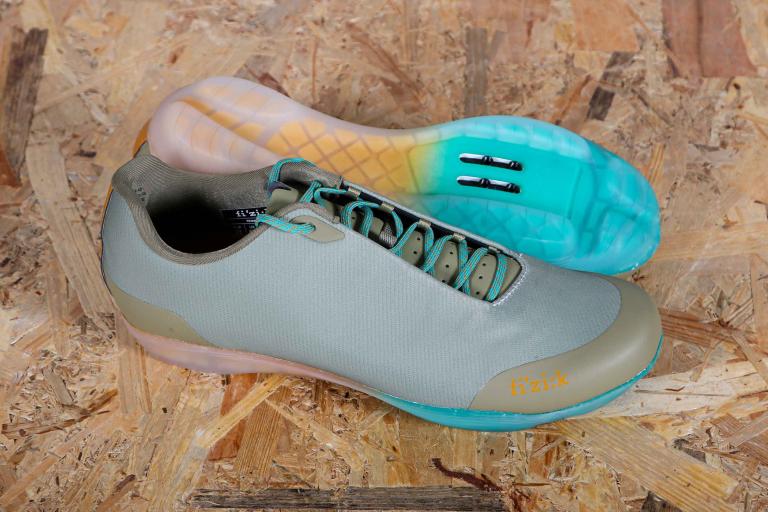
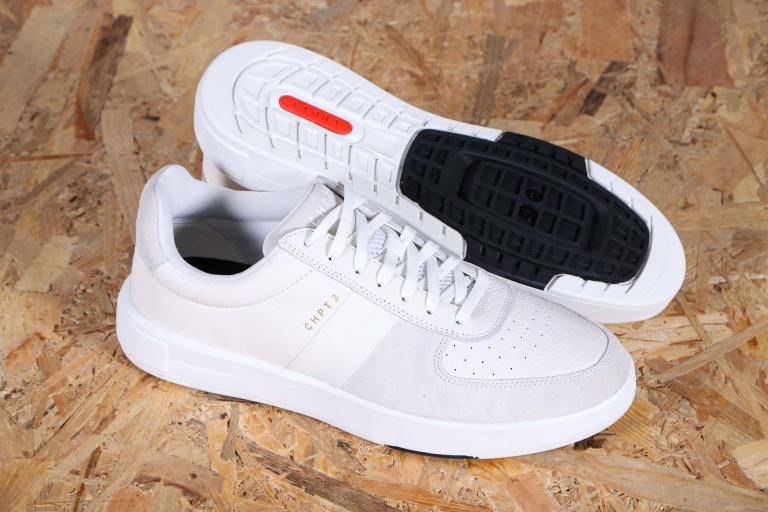
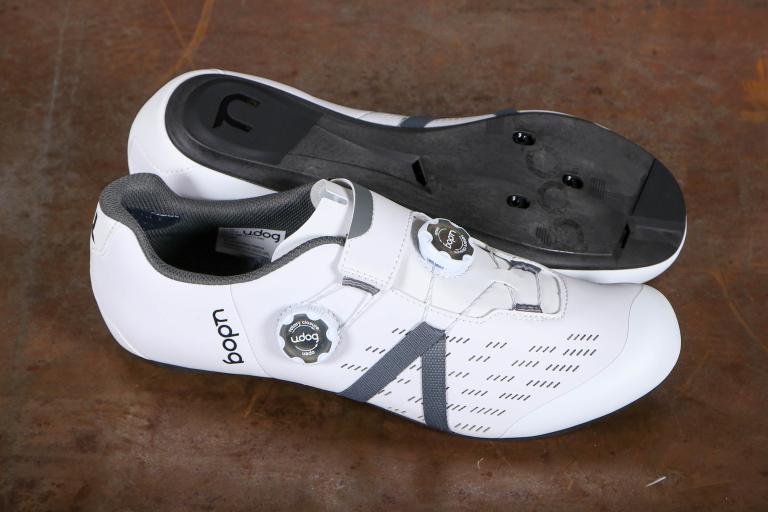
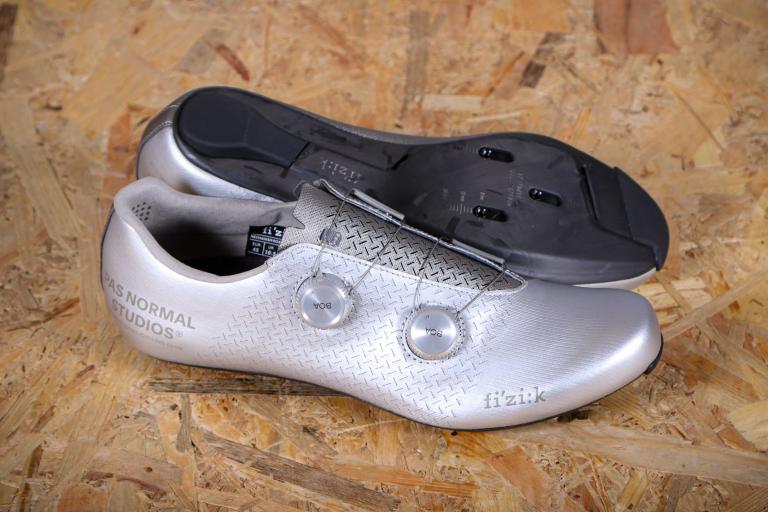
Add new comment
4 comments
Had these for a month. Very pleased overall. Love the feel on the bike. High ankle support provides really solid pedal action. I adjust the front BOA to be looser – so front of foot has room to wiggle and stay warm, while back BOA clamps the entire foot and ankle providing rigid pedalling platform. I went 0.5 size larger to provide room for woolly sock. My feet usually freeze, but these keep things tolerable. Rode in 35′F for 2.5 hours today. Best is feet do not sweat, which will make your feet cold!
I seem to know an awful lot of people with poor foot circulation. I've been wearing Northwave Fahrenheit boots with shimano road cleats. The first winter I have been able to ride all day I all weather without cold feet, though I did cheat twice when bellow zero c by using hotties toe warmers.
The NW were waterproof with gortex lining and warm as insulated!!
I have these boots and used them November-January. I purposely bought them a size larger so that I could wear thicker wool socks. My feet still got cold and as there was still a bit of volume in the shoe, my foot was able to move around too much. Mine are a size 38, if you know anyone interested in buying a used pair, mine are for sale!
Cold toes after 1 or 2 hours of riding sounds like (imho) a circulatory issue not a shoe problem. I have the same problem and find using the right sock and sock liners (thermal and NTS layers) more effective than adding insulation to my shoes (the barrier layer).
Since I am looking for a proper rain shoe to replace my homemades, I am curious as to the temperature range you rode in.